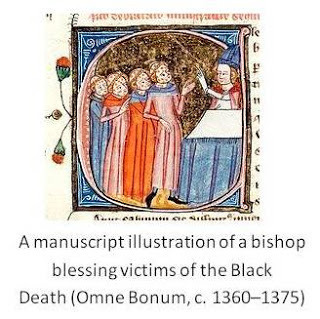Bishops Behaving Badly (In Medieval Times) by Lana Williams
 Today I'd like to welcome Lana Williams to History Undressed! I had the pleasure of meeting Lana in person this summer at the RWA Conference. I do hope you enjoy her post about naughty medieval bishops!
Today I'd like to welcome Lana Williams to History Undressed! I had the pleasure of meeting Lana in person this summer at the RWA Conference. I do hope you enjoy her post about naughty medieval bishops!Bishops Behaving Badly (in Medieval Times)by Lana Williams
I’ve just released my third historical romance, Believe In Me, where the villain of the story is...you guessed it...a bishop. Why? Well, I came across some delicious research that discussed the challenges the Church faced during medieval times and found it fascinating. Needless to say, the ideas started flowing.
During this period, many nobles chose to leave their estates (or part of them) to the Church with the hopes of receiving a material or spiritual benefit (on earth or in heaven). As the Church gained more and more land (aka wealth and power), their method of managing it had to change as well. About this same time, it became law that the eldest son would inherit, which left the other sons (and daughters) at loose ends. Many ended up in the Church as abbots, cardinals, or bishops not because of a religious calling but because those positions had a similar status as that of nobility.
Can you see where all of this is going? An entity with an abundance of wealth and people in charge of it who
 saw no reason not to spend it as they saw fit - the perfect storm in many ways. Obviously there were many monasteries and abbeys that managed their wealth wisely and did a lot of good for the general population. And just as obviously, there were some who built lavish cathedrals and holdings filled with valuable objects. A few religious leaders lived like kings.
saw no reason not to spend it as they saw fit - the perfect storm in many ways. Obviously there were many monasteries and abbeys that managed their wealth wisely and did a lot of good for the general population. And just as obviously, there were some who built lavish cathedrals and holdings filled with valuable objects. A few religious leaders lived like kings.Some historians point to the early tenth century as being the low point. Entire books have been written on the subject, but I’ll just share some of the more interesting tidbits I found.
Elections for positions in religious houses caused great conflicts in towns. This was very political and the families of those being considered often got involved. The office of the Bishop of Rome served as a platform for opposing noble families, each vying for control. This power struggle continued for centuries.
In London, the Brothels called ‘stews’ in medieval times were controlled by the Bishop of Winchester, where the women were known as the ‘Winchester Geese’. These women were denied a holy burial despite being allowed (some might say encouraged) by the bishop to ply their trade. The bishop made a lot of money from fines and sharing in their earnings. Seems like a conflict of interest, don’t you think?
This sort of behavior was not limited to bishops. Prior Gilbert de Ponteburgh of Thurgarton Priory was accused of adultery with two local women in 1284. John Rastle, a canon at St. Augustinian’s in Bristol was a ‘public player of dice’ and other unlawful behavior. Apparently this behavior followed him from his time as a student at Oxford.
Pope Formosus was convicted after his death in 856 of having illegally seized the papal throne. His body was dug up and put on trial. After being found guilty, his body was stripped of any priestly vestments, the fingers of his right hand were cut off (the hand that gives benediction) and his body was thrown in the river.
The abbot of the Benedictine house at Milton was criticized for lavish expenditures on his living quarters, but he also founded a free grammar school for the townspeople’s sons. The man was obviously not all bad. In Sherborne, 1437, the townspeople were so displeased with their religious leaders that they set fire to the abbey church! In 1528, Dame Eleanor Carey was being considered for abbess of a large and wealthy nunnery, but under much competitive pressure, she confessed to having had two children during her time at the nunnery.
 The granting of indulgences, which became generally accepted with the first Crusade and grew from there, was a fundraiser of sorts. A person who committed a sin was granted forgiveness and a payment of money or service could be made to eliminate the debt of forgiveness. As you might imagine, this was taken advantage of by both parties involved. In some areas, indulgences were sold on a large scale. People feared purgatory and were willing to pay handsomely to avoid it. A Dominican friar in the early 16th century, Johann Tetzel, offered indulgences for the dead with a clever slogan: “When a penny in the coffer rings, a soul from purgatory springs.”
The granting of indulgences, which became generally accepted with the first Crusade and grew from there, was a fundraiser of sorts. A person who committed a sin was granted forgiveness and a payment of money or service could be made to eliminate the debt of forgiveness. As you might imagine, this was taken advantage of by both parties involved. In some areas, indulgences were sold on a large scale. People feared purgatory and were willing to pay handsomely to avoid it. A Dominican friar in the early 16th century, Johann Tetzel, offered indulgences for the dead with a clever slogan: “When a penny in the coffer rings, a soul from purgatory springs.”Hope you found these stories as interesting as I did!
One lucky commenter will win an ebook version (Kindle, Nook, or Kobo) of Believe In Me. Simply share whether you’re surprised or not at some of the behaviors I shared. (Please be sure to leave your email address!)
 Believe In Me is Book III of The Vengeance Trilogy. Here’s a little something about the story:
Believe In Me is Book III of The Vengeance Trilogy. Here’s a little something about the story:A knight determined to honor his vow.A lady set on vengeance.Only love stood in their way.
Lady Cristiana’s plan to seek revenge against her mother’s murderer is cut short when a world-weary knight arrives to escort her to her new guardian, a powerful bishop. Cristiana refuses to become a ward of the bishop whom she suspects was involved in her mother’s death, but the knight leaves her no choice.
Sir William de Bremont hopes to earn a second chance at the life he was given but believes he doesn’t deserve. Serving the bishop seems the perfect solution, except Lady Cristiana thwarts him at every turn, captivating him body and soul.
Cristiana has the unique ability to heal the sick through her touch. Accustomed to hiding her gift, the wall she’s built to protect herself crumbles under William’s passionate regard. Honor-bound to deliver her despite her protests and his own doubts, William reluctantly fulfills his vow only to realize the depth of his mistake.
As William and Cristiana’s love grows, they realize the bishop plans to use her ability to fulfill his own destiny with little concern for the life of others, including Cristiana’s. The bishop’s treachery comes to light, forcing Cristiana to choose between revenge or the love of a lifetime.
Available on:Amazon: http://amzn.to/19Q6UP7Amazon UK: http://amzn.to/13GpgjPBarnes & Noble: http://bit.ly/14C3caWKobo: http://store.kobobooks.com/en-US/ebook/believe-in-me-6
Lana Williams writes historical romance filled with mystery, adventure, and a pinch of paranormal to stir things up. Her medieval romances begin with A Vow To Keep, the first in The Vengeance Trilogy, followed by Trust In Me and Believe In Me.
Filled with a love of books from an early age, Lana put pen to paper and decided happy endings were a must in any story she created. She writes in the Rocky Mountains with her husband, two growing sons, and two dogs.
Connect with her at:www.lanawilliams.netwww.facebook.com/LanaWilliamsBooksTwitter @LanaWilliams28Goodreads: http://bit.ly/YtJ5FX
Published on August 22, 2013 05:47
No comments have been added yet.



